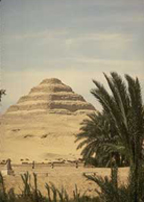
Archaeologists working in Saqqara, about 20 kilometres south of Giza, home of
the Great Pyramids, unearthed the remains of a 4300 year-old pyramid under 20
metres of sand.
It is the 138th pyramid discovered in Egypt and the 12th in the region of
ancient Memphis, the capital of Egypt's Old Kingdom. Only about a dozen remain
intact, the rest are in ruins.
Dr. Zahi Hawass, secretary general of Egypt's Supreme Council of Antiquities,
said that it probably was the tomb of the queen mother Sesheshet of the 6th
Dynasty who lived several hundred years after the Great Pyramids were built.
About 3 months ago the excavators discovered the base of a structure with sides
22 metres long. Using parts of the limestone casing with its exquisite
hieroglyphic details, they were able to determine that the structure was
initially 14 metres high.
The team hopes to find the burial chamber and inscriptions of the queen or other
artifacts that have not been looted by robbers in antiquity.
Egypt was a remarkable civilization lasting thousands of years and only in the
last few decades have we been able to begin to grasp its truly remarkable
artistic, scientific, engineering and medical achievements, and to appreciate
the complex culture built on knowledge, philosophy. spirituality and vision,
thanks in part to dedicated Egyptologists and persistent archaeologists.
Egypt has long been the Land of Magic and Mystery. The Rosetta stone, a 760
kilogram stele, provided a key to unlocking some of the mystery. On it was
inscribed in 196 B.C. a decree in two Egyptian language scripts and one in
classical Greek. Found in 1799 the translations made it possible to decode the
symbolic language leading to a better understanding of the ancient culture from
which we have received much and from which we still have much to learn.